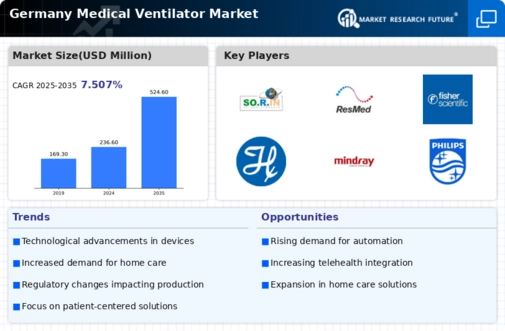Rising Awareness of Respiratory Health
There is a growing awareness of respiratory health among the German population, which is positively impacting the medical ventilator market. Public health campaigns and educational initiatives have increased understanding of respiratory diseases and the importance of timely intervention. This heightened awareness is leading to more individuals seeking medical assistance for respiratory issues, thereby increasing the demand for ventilatory support. Furthermore, healthcare professionals are emphasizing the need for early diagnosis and treatment, which is likely to drive the adoption of medical ventilators in clinical settings. As awareness continues to rise, the medical ventilator market is expected to expand, with more patients benefiting from advanced respiratory care solutions.
Investment in Healthcare Infrastructure
Germany's commitment to enhancing its healthcare infrastructure significantly impacts the medical ventilator market. The government has allocated substantial funding, approximately €5 billion, to improve hospital facilities and expand intensive care units (ICUs). This investment aims to ensure that healthcare institutions are equipped with state-of-the-art medical equipment, including ventilators. As hospitals upgrade their facilities, the demand for advanced ventilators is expected to rise. Additionally, the focus on increasing the number of ICU beds, which has seen a growth of 15% in recent years, further emphasizes the need for reliable ventilatory support. Consequently, the medical ventilator market is poised for expansion as healthcare providers strive to meet the growing demands of patient care.
Technological Innovations in Ventilation
The medical ventilator market is significantly influenced by ongoing technological innovations. Manufacturers are increasingly developing advanced ventilators that offer features such as non-invasive ventilation, smart monitoring systems, and enhanced portability. These innovations are designed to improve patient comfort and outcomes, which is crucial in a competitive healthcare landscape. For instance, the introduction of portable ventilators has expanded the market's reach, allowing for use in both hospital and home care settings. The market for portable ventilators is projected to grow by 20% annually, reflecting the shift towards more versatile medical equipment. As technology continues to evolve, the medical ventilator market is likely to witness further advancements, enhancing the overall quality of care provided to patients.
Government Support and Funding Initiatives
Government support plays a crucial role in shaping the medical ventilator market in Germany. Various funding initiatives aimed at enhancing healthcare delivery have been introduced, including subsidies for hospitals to acquire advanced medical equipment. The German government has earmarked approximately €1 billion for the procurement of medical devices, including ventilators, to ensure that healthcare facilities are adequately equipped. This financial backing not only facilitates the purchase of high-quality ventilators but also encourages innovation within the industry. As a result, the medical ventilator market is likely to experience growth driven by both increased availability of funds and the push for improved healthcare standards across the nation.
Increasing Prevalence of Respiratory Diseases
The medical ventilator market in Germany is experiencing growth due to the rising prevalence of respiratory diseases such as chronic obstructive pulmonary disease (COPD) and asthma. According to recent health statistics, approximately 10% of the German population suffers from some form of chronic respiratory condition. This increasing patient population necessitates the availability of advanced medical ventilators to ensure effective treatment. Furthermore, the aging population, which is more susceptible to respiratory ailments, is projected to reach 22% by 2030. This demographic shift is likely to drive demand for ventilatory support, thereby enhancing the medical ventilator market. As healthcare providers seek to improve patient outcomes, the integration of innovative ventilator technologies becomes essential, indicating a robust growth trajectory for the medical ventilator market in Germany.





















Leave a Comment